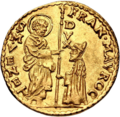
The sequin (/ˈsiːkwɪn/; Venetian and Italian: zecchino [dzekˈkiːno]) is a gold coin minted by the Republic of Venice from the 13th century onwards.
The design of the Venetian gold ducat, or zecchino, remained unchanged for over 500 years, from its introduction in 1284 to the takeover of Venice by Napoleon in 1797. No other coin design has ever been produced over such a long historical period.
The reverse bears a motto in Latin hexameter: Sit tibi, Christe, datus // quem tū regis, iste ducātus ("Christ, let this duchy that you rule be given to you").
YouTube Encyclopedic
-
1/1Views:312
-
Sequin pencil case.
Transcription
History
Initially called "ducat" (ducato), for the ruling Doge of Venice who was prominently depicted on it, it was called the zecchino, after the Zecca (mint) of Venice, since 1543 when Venice began minting a silver coin also called a ducat. The name of the mint ultimately derives from Arabic: سكّة (sikka), meaning a coin mould or die.
In some regions, in later centuries, this type of coin was stitched to women's clothing such as headdresses – this eventually led to the origin of the more modern word "sequins" to denote small shiny, circular decorations. Following the Venetian model, similar coins were used for centuries throughout the Mediterranean. After two hundred years of continuous zecchino production, the Byzantine Empire imitated with the basilikon. In 1478, the Ottoman Empire introduced a similar unit. In 1535, the Knights Hospitaller of Malta did so. The Ottoman and the Maltese coins were also gold.
Coin collectors often try to accumulate a complete set of zecchini of "all the Doges".
See also
Further reading
- Zecchini (Sequin) by the Knights Hospitallers Archived 2021-12-23 at the Wayback Machine
References
- ^ Cuhaj, George S., ed. (2009). Standard Catalog of World Gold Coins 1601–present (6 ed.). Krause. p. 952. ISBN 978-1-4402-0424-1.
External links
- . Encyclopedia Americana. 1920.
- . Encyclopædia Britannica (11th ed.). 1911.
- The Dictionary of Coin Denominations

